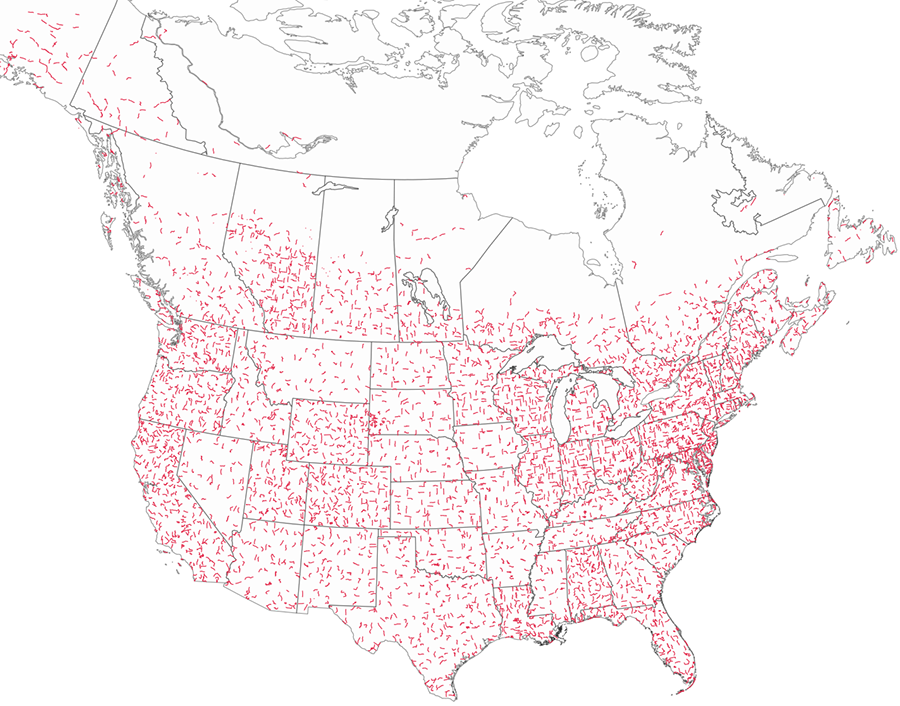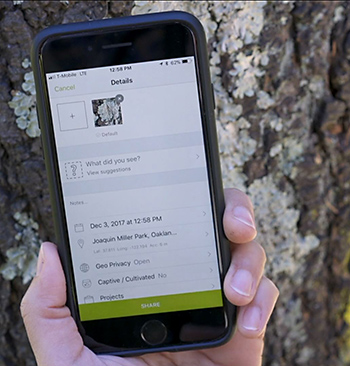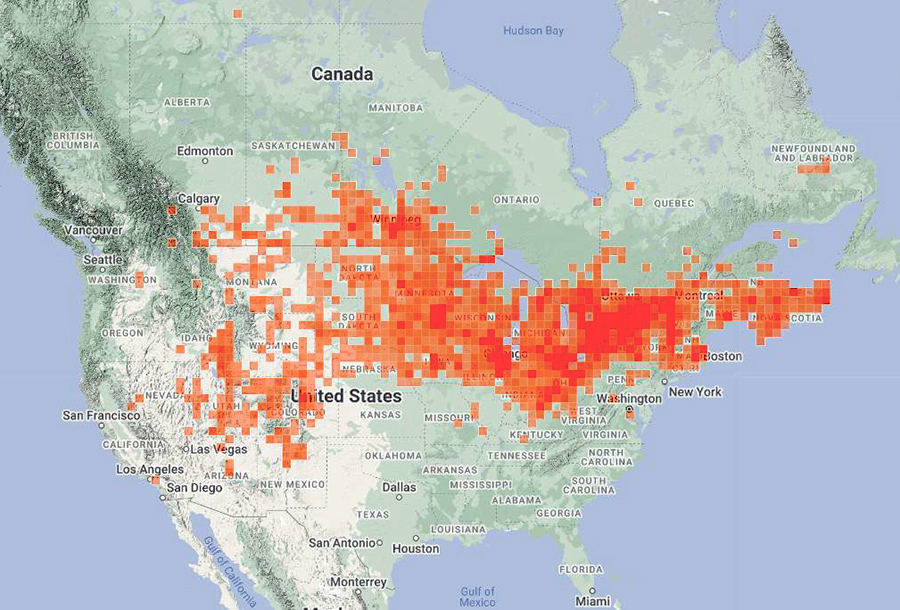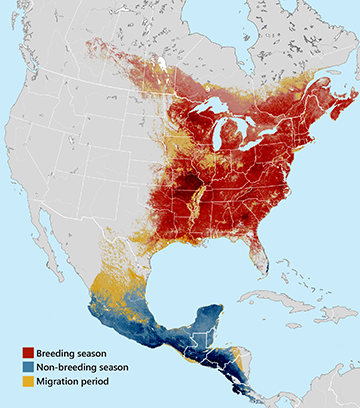Citizen Science
Field research by academic and government scientists has been the source of most of the quantitative data used to support conservation. However, this is not the only approach available. Over the past few years there has been an explosion in citizen science, largely thanks to new smartphone apps linked to online databases (McKinley et al. 2017). Through the efforts of volunteer naturalists, millions of species observations are being added to online databases each year.
Citizen science is not new—observing and documenting animals and plants is something that naturalists have always done. What’s new is the enormous increase in participants and the rapid, widespread sharing of information made possible by the Internet. The quality of observations has also increased, through the inclusion of photographs, sound recordings, automatic time stamps, and GPS locations.
The Contribution of Citizen Science
Citizen science is the practice of engaging the public in scientific projects that produce reliable quantitative information usable by scientists, decision-makers, and the public (McKinley et al. 2017). In the field of conservation, most citizen science projects focus on broad-scale species monitoring. These projects provide information on species abundance, species distribution, migratory patterns, and the timing of natural processes such as flowering. Some projects focus on monitoring aquatic and terrestrial habitat quality. In addition, researchers and resource managers sometimes recruit volunteers to help collect data for specific research studies.
The core strength of citizen science is the large number of observers it engages. This complements the main weakness of conventional science, which is limited capacity. Scientists are very good at collecting high-quality data, but there just aren’t enough of them. Placing literally millions of additional observers in the field makes a tremendous difference in what can be achieved. Through citizen science, we can monitor across vast spatial scales and over extended time frames. We can also track uncommon species and species that are generally overlooked through conventional monitoring programs.
Structured Projects
Citizen science projects come in two main forms: structured and unstructured (Callaghan et al. 2018). Structured projects are established for a defined purpose. Typically, the organization or individual that initiates the project also leads the analysis of the data and the application of the findings. Structured projects are characterized by well-defined protocols that observers must follow. These protocols define what is to be studied as well as standardized methods for making observations.
The Breeding Bird Survey provides a good example of a structure project. Each spring, experienced volunteers count birds along a series of fixed survey routes using a standardized observation protocol (Fig. 4.2). Observers stop every 800 m along their assigned route and count all birds they see or hear over three minutes. The count begins 30 minutes before sunrise on a suitable day between May 28 and July 7.

The Canadian Wildlife Service oversees the program in Canada and analyzes the data and generates regular reports on the state of birds in Canada. Data generated by the Breeding Bird Survey have contributed to over 500 peer-reviewed papers and the data are used in many policy decisions, including species listings. No better dataset exists for tracking wide-scale changes in bird abundance over time.
Unstructured Projects
Unstructured projects are more open-ended. Generally, the intent is to build a database of observations without explicitly defining what the data will be used for. Projects may impose some requirements on observers, such as requiring a photograph or limiting which species are to be included. But participants are otherwise free to make observations whenever and wherever they please.
Unstructured projects can make an important contribution to conservation science despite the opportunistic nature of the observations. In the case of iNaturalist and eBird, the two largest projects, size is a key factor—these projects are global in scope and have millions of participants. Never in the history of science has so much information been collected about so many species. The large number of observations permits meaningful insights to be made, despite biases and variability among observers.
iNaturalist

iNaturalist is an online platform and associated smartphone app used to record citizen science observations (Fig. 4.3). The observations are unstructured: participants can submit sightings of any species they wish at any time of the year. Most observations are made using the smartphone app and consist of a photograph or sound recording of an individual species together with a time stamp and GPS location. Participants are prompted for a preliminary species identification, which is later verified by the iNaturalist community of naturalists. After the species identification has been verified, the observation is labelled as “research grade” and considered suitable for statistical analysis.
As of 2023, the iNaturalist database contains over 130 million observations of 420,700 species. Within Canada, there have been 9.8 million observations of 34,919 species. The database is available to everyone at no charge and can be filtered by region, species, and date.
The strength of iNaturalist is that it generates an enormous number of observations over a wide spatial and temporal extent. As such, it excels at describing species distributions, especially of species that are overlooked or difficult to monitor using conventional methods (Fig. 4.4). It is less suited to estimating species abundance because the sampling effort is unknown and because observers do not provide a complete inventory of species at a given location. That said, statistical methods are being developed to maximize the value of such “presence only” datasets (e.g., Fithian et al. 2014). Users of the data also have to account for several forms of observation bias, such as proximity to population centres and the ease of photographing a given species (Callaghan et al. 2021, Feldman et al. 2021).

eBird
Like iNaturalist, eBird is an online platform with an associated smartphone app. Since its release in 2002, it has quickly become a favoured resource for birders around the globe. As of 2023, 820,000 birders have contributed more than 1.3 billion observations to the database (eBird 2023).
eBird uses a checklist approach, carried over from the pre-digital era. The intent is to list every bird seen or heard on an outing, creating a complete census of a site. The eBird app facilitates the recordkeeping process while also tracking the duration of the outing (a measure of sampling effort) and the GPS location. The app also flags unexpected sightings to minimize reporting errors.

Because eBird checklists are contributed throughout the year, and at the global scale, they provide unparalleled insight into bird distributions and migratory patterns (Fig. 4.5). Moreover, the checklist approach provides a measure of both species presence and absence at each survey location, as well as a measure of observer effort, permitting the estimation of relative abundance and trends over time (Fink et al. 2020). Like iNaturalist, observation biases exist and must be taken into account (Feldman et al. 2021).
Applying Citizen Science to Conservation
With the rising profile of citizen science in recent years, the number of projects has greatly increased. The value of these projects for supporting conservation is variable and can be assessed on six main criteria (AEP 2020):
- Accessibility. Projects should facilitate the broad, public sharing of information (at no charge). Projects that maintain private databases are less desirable.
- Data products. Projects with the capacity and technical expertise to analyze the incoming observations and provide data products such as distribution maps and summary reports are preferable to projects that just store the data.
- Spatial and temporal scope. Species do not respect administrative boundaries. Therefore, all else being equal, a national or global project is preferable to one that is local in scope. Similarly, projects that collect observations all year long are preferred over projects that provide only a snapshot at a particular time of year.
- Data quality. Projects that have standardized protocols for making observations generate higher-quality data than projects that do not. So do projects that check the validity of species identifications submitted by observers. High-quality data facilitates the ability of researchers to draw meaningful insights from the observations.
- Application. Projects that have the attention of researchers and resource managers are preferred over those that do not. The more direct the connection between observations and their management application, the better.
- Data security. It is an unfortunate reality that citizen science initiatives sometimes shut down after a period of time, typically because of a lack of funding, a change in an organization’s priorities, or the loss of key people. Some projects have also lost data (mainly in the era before cloud-based storage). Therefore, consideration should be given to the long-term viability of the project and its ability to store data reliably.
Despite the inherent benefits of large projects, the value of small, local projects should not be discounted. A small project may have very high conservation value if it is focused on gathering data for a specific local application. In other words, purpose and application are overriding factors.
To be clear, citizen science is not a competitor to conventional research. Well-designed research projects will always be the best approach for generating high-quality information with high efficiency. But there is a limited supply of researchers and project funding, which severely constrains what can be accomplished through conventional field studies. Consequently, conservation researchers and practitioners are increasingly turning to citizen science to augment (not replace) the information available from conventional studies (Adde et al. 2021). For example, in 2022 alone, 1,775 academics downloaded the eBird dataset for analysis and published 160 peer-reviewed papers using this information (eBird 2023). Citizen science is also increasingly used by managers to inform species management decisions (McKinley et al. 2017, Ruiz-Gutierrez et al. 2021).

